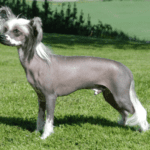The Korat is a medium-sized cat, characterized by its muscular and athletic build. While bearing a resemblance to the Russian Blue, the Korat has a single coat (as opposed to a double coat), a more rounded body shape, and distinctive peridot green eyes instead of emerald.
Females of this breed tend to display a more refined demeanor compared to males. The head, when viewed from the front, exhibits a characteristic heart shape, with a broad structure around the eyes. The forehead is broad and flat, and the nose slopes slightly downward, featuring a distinct stop between the forehead and nose. A robust and well-defined chin and jaw complete the facial profile.
Noteworthy are the large ears that taper from a broad base to a rounded tip, set high on the head to convey a vigilant expression. The eyes, prominent and shiny, are bright peridot green, with a slight amber cast considered acceptable in show cats.
The body is strong and muscular, with a curved back that distinguishes it from the elongated Siamese and the more compact British Shorthair. The back legs are slightly longer than the front legs in proportion to the body. The tail is of medium length, broad at the base, and tapers to a rounded tip.
- Origin: Thailand
- Length: 15 to 18 inches
- Height: 9–13 inches
- Weight: 6–10 pounds
- Lifespan: 10–15 years
Breed Characteristics
The Sundar Korat typically reaches full maturity between two to four years of age. Despite adulthood, it remains a moderately sized cat, characterized by a muscular and robust build. Adorned with a stunning silvery-blue coat that exudes a captivating glow, the Sundar Korat is a cat that effortlessly commands attention, asserting a sense of authority within its family.
Known for its affectionate nature and high intelligence, the Korat tends to form harmonious relationships with both adults and children, provided it receives ample attention on its own terms. While these rare felines generally coexist amicably with other household pets, they may exhibit signs of jealousy if they perceive another animal as encroaching upon their perceived territory.
| Affection Level: High |
| Friendliness: High |
| Kid-Friendly: Medium |
| Pet-Friendly: Medium |
| Exercise Needs: Medium |
| Playfulness: High |
| Energy Level: Medium |
| Intelligence: High |
| Tendency to Vocalize: Medium |
| Amount of Shedding: Low |

History
The potential initial mention of the Korat breed can be traced back to the Thai Tamara Maw, a manuscript dating between 1350 and 1767 CE, currently housed in the National Library of Thailand. However, the depiction of the Korat in this historical document lacks the detail needed to conclusively identify the depicted cat caste.
In more recent times, the Korat has been featured on postage stamps in Thailand, with an illustrative example on display at the Korat post office in the city.
The Korat made its early appearances in Britain between 1889 and 1896 under the name “Blue Siamese.” However, these solid blue cats did not align with the cat show judges’ expectations for a Siamese cat, leading to their disappearance from the show scene by 1901.
Among the early imports, a cat named “Dvina,” owned by Russian Blue breeder Mrs. Constance Carew-Cox, is noted in Francis Simpson’s The Book of the Cat (1903) for reportedly producing a significant number of “Siamese” kittens. Another cat, Mrs. B. Spearman’s Blue Siamese male named “Nam Noi,” faced disqualification as a Siamese but found acceptance in the Russian or any other blue class, securing a first-place position (WR Hawkins, “Around the Pens,” July 1896). Spearman’s attempts to import more of these “Blue Siamese” proved unsuccessful.
The Korat made its debut in the United States during the 1950s. In 1959, Cedar Glen Cattery played a pivotal role by importing the first pair of Korats to the U.S. for breeding—a male named Nara and a female named Dara. The Korat achieved championship status in 1966, thanks to the efforts of a dedicated Maryland breeder.
Appearance
These felines, ranging from small to medium-sized, boast solid, robust bodies that carry a weight surprising for their size. The defining feature of the Korat’s appearance lies in its sleek fur, presenting a striking silvery-blue hue devoid of stripes, white markings, or additional colors on the mature cat’s body—though faint tabby “ghost” markings are permissible in kittens.
The nose skin should exhibit a lavender to blue tone, mirroring the hue of the paw pads. The preferred eye color is a vivid green, while amber is an acceptable alternative. The true eye color typically fully develops between two to four years of age.
When viewed from the front, a Korat’s head assumes a distinctive heart shape, complemented by moderately large, upright ears that contribute to the cat’s alert countenance. Their eyes, relatively large in proportion to their heads, further enhance their distinctive appearance.
Despite the Korat’s sleek and short fur, which minimizes shedding, it’s important to note that these cats do not qualify as truly hypoallergenic.
Temperament
Known for their profound intelligence, the Korat stands out as a contemplative and considerate member of the household. In comparison to many cats, Korats exhibit a quieter demeanor. While they do engage in play and activity, they derive equal contentment from snuggling on their owner’s lap.
Dr. Sarah Wooten emphasizes the Korat’s ability to form deep connections with their human family, expressing affection through cuddling. She notes their high intelligence, enjoyment of food puzzles, affinity for children with proper socialization, and enthusiasm for training and games.
Around strangers, Korats may display a degree of clumsiness or aloofness, yet their focus remains on their family for safety, observing the surroundings from their vantage point.
Korats adapt well to multi-pet households, particularly thriving in the company of fellow Korats. However, their social and serene nature enables them to learn to coexist harmoniously with other cats and cat-friendly dogs, provided that socialization and introductions are approached with patience. Regardless of the presence of other animals, ensuring an ample supply of toys is essential.
Personality
Unlike their more vocal Siamese counterparts, Korats employ alternative methods to communicate their desires. During mealtime, they may encircle your ankles, perch on your shoulders, or playfully nip at your shin if the cat food is not promptly provided. However, when they have something significant to convey, they express their thoughts vocally.
Scoring an 8 on the cat-activity level scale, Korats are socially inclined, playful, and brimming with vitality, yet they do not exhibit hyperactive bouncing-off-the-walls behavior. Possessing notable intelligence, Korats share with Siamese cats a penchant for chasing bouncy toys, sunbeams, and bits of paper, actively involving their esteemed human companions in these favored pastimes.
Korats harbor a strong desire for affection from their human companions, employing their cognitive abilities to secure coveted spots on laps, hands, and, ultimately, in the hearts of those who care for them.
Health
Given its nearly 800-year history as a naturally occurring breed, the Korat generally maintains good health, as noted by the KTCA. However, like any cat, Korats may be vulnerable to certain common feline health issues.
Dr. Sarah Wooten emphasizes, “Like all cats, Korats are prone to obesity and dental disease.” To proactively address these concerns, maintaining the cat’s fitness, providing high-quality nutrition, and ensuring proper dental care are crucial steps.
As cats age, they may be at risk for kidney disease and hyperthyroidism. Additionally, some Korats may have sensitive stomachs, manifesting as frequent vomiting or diarrhea. Dr. Wooten recommends addressing these concerns by providing sensitive cat food and avoiding abrupt dietary changes or the inclusion of human table food.

Care
The Korat cat is known for its high intelligence, playful demeanor, and affectionate nature. These intelligent felines establish strong bonds with their human companions, actively participating in daily activities. Due to their social nature, Korats may not thrive when left alone for extended periods. Having a companion, whether another pet or their owner, helps prevent separation anxiety and ensures a contented disposition.
Exercise is crucial for Korats, and they particularly enjoy interactive games with their people. Playtime serves as a bonding experience, and these energetic cats relish positive interactions with their humans. Many Korats even delight in playing fetch, showcasing their high intelligence that makes training them a rewarding experience. Teaching tricks and providing puzzle toys can both entertain and challenge these clever cats.
Maintaining your Korat’s grooming routine is essential for its health and cleanliness. With a single-layer short coat, grooming is straightforward, requiring only a weekly brush or two to keep their silvery-blue fur shiny and well-maintained. Regular nail trimming, teeth brushing, and ear cleaning should also be part of the grooming regimen.
While the Korat is generally considered low-shedding, it’s crucial to note that they are not completely hypoallergenic. Although stroking a well-groomed Korat is less likely to cause irritation compared to other breeds, it’s essential to be aware of potential allergens for individuals with allergies.
Best Food For
- Hill’s Prescription Diet t/d Dry Cat Food
- Hills Prescription Diet – Wet Cat Food – Urinary Care with Ocean Fish c/d feline (156g)
- Hill’s™ Prescription Diet™ a/d™ Canine/Feline
- Hill’s™ Prescription Diet™ c/d™ Multicare Feline with Ocean Fish
Best Korat Cat Diet (Feeding)
A Korat cat typically requires approximately 70-80 kilocalories of food per kilogram of body weight per day. Not prone to obesity, these cats generally consume only the necessary amount to maintain their weight.
Grooming
Ensuring the well-being of your Korat cat involves regular grooming practices. Given their short, easily manageable coat, brushing a few times a week is sufficient. This helps minimize hairballs and reduces loose cat hair in your home.
Dental care is crucial, and brushing your cat’s teeth several times a week with cat-safe toothpaste is recommended. Although it may take time for your feline to adjust to this routine, maintaining good oral hygiene is essential at any age.
Routine eye care involves cleaning the corners of your cat’s eyes as needed. A soft, damp cloth can be used for gentle wiping, ensuring different corners or separate cloths for each eye.
Similarly, cleaning your cat’s ears is part of the grooming routine. A soft cloth or cotton ball, along with a cat-safe ear cleaner, can be used to gently clean the outer ears. Avoid using cotton swabs to prevent accidental injury.
Nail trimming is required every few weeks to a month. If your cat is resistant, consider trimming one paw at a time or using calming techniques like wrapping your cat like a burrito. Ensure each grooming activity is a positive experience, followed by treats and affectionate gestures.
Training and Exercise
Transform your home into your Korat’s ultimate playground! These cats thrive on running, jumping, and climbing. Installing tall cat trees, scratching posts, and an array of toys not only safeguards your belongings but also offers secure and socially acceptable outlets for your cat’s physical activity requirements.
Korat cats relish interaction with their human and animal companions. For moments when you’re unavailable to engage directly, consider introducing food puzzles and other stimulating toys to keep your kitty entertained.
Lacking adequate mental stimulation, these clever cats swiftly devise their amusement, exploring closets and drawers, and engaging with your belongings.
Adoption center
Locating a purebred Korat might pose more of a challenge compared to some other breeds, yet the quest for the perfect one is truly worthwhile. Given their rarity, these cats are not commonly found in shelters or rescues.
Attending a cat show is a recommended approach, allowing you to engage with various breeders, including those specializing in Korats. Additionally, The Cat Fancier Association website can serve as a valuable resource for identifying reputable breeders.
See More Cat Breeds For Further Research
FAQs
Are Korat cats good as pets?
Korats are affectionate cats that thrive in homes where someone is present most of the time. Similar to many felines, they may not enjoy being handled by very young children but generally fare well with older children who can understand and respect the cat’s space and needs.
How can you identify a Korat cat?
The distinctive features of a Korat cat include a blue, silver-tipped coat and striking green eyes. Observing the cat’s heart-shaped face with smooth, curved lines, a slightly downward-tilted nose, and strong, well-developed jaws are key identifiers.
Are Korat cats rare?
In the Americas, Korats are considered a rare or minority breed, primarily due to their limited gene pool. Being confined to their native Thailand makes it challenging for breeders to introduce new genetic diversity through imports.
What sets Korat cats apart from Russian Blues?
Korats feature a heart-shaped head and hail from Thailand, displaying a single coat of short, fine fur that starts as light blue and darkens with age, ending in silver tips. In contrast, Russian Blue cats have a wedge-shaped head, originated in Russia, and possess a double coat with silver guard hairs.
Do Korat cats enjoy being held?
Korats tend to be quieter than most cats, finding joy in play and activity. Nevertheless, they are equally content to cuddle on their owner’s lap, showcasing their adaptable and affectionate nature.












Great work! That is the type of information that are meant to be shared across the internet. Disgrace on the search engines for not positioning this publish upper! Come on over and visit my site . Thanks =)